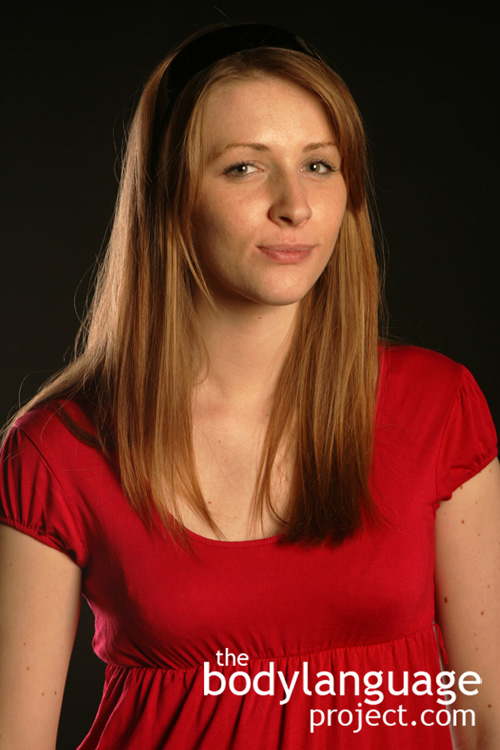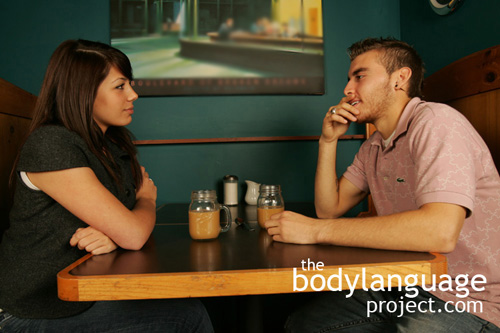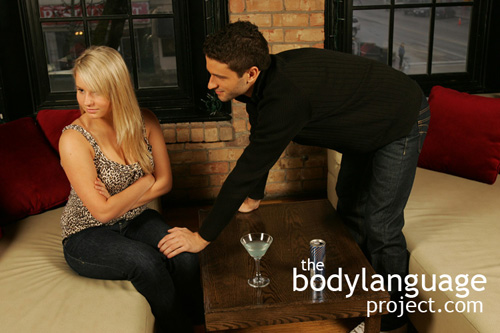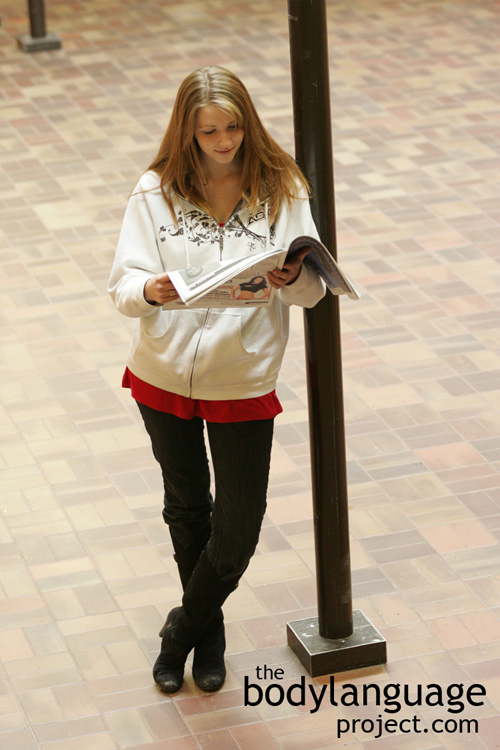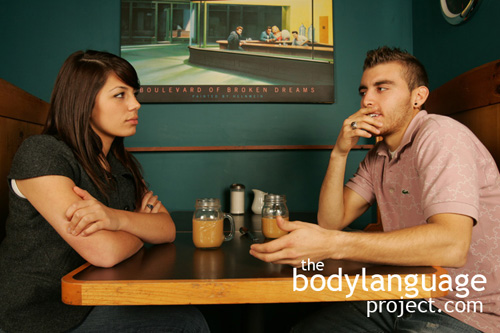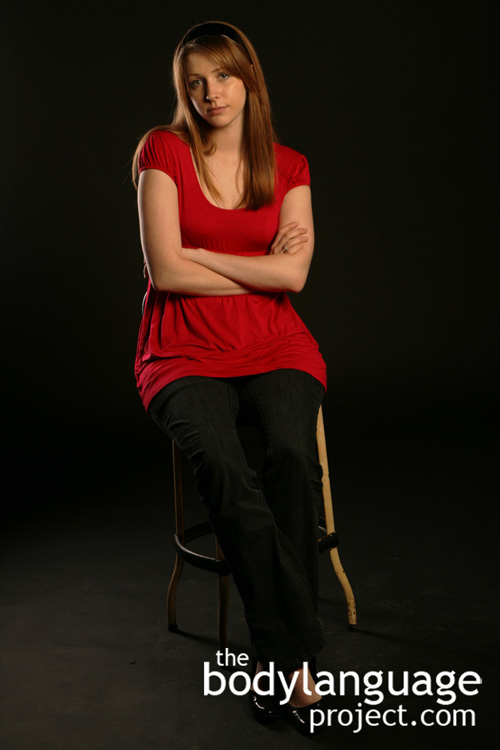Body Language of Compressed Lips or Stiff Upper Lip
Synonym(s): Tight Lips, Lip Compression, Disappearing Lips, Stiff Upper Lip, Inward Lip Roll, Lip Pursing, Lip Puckering, Pursed Lips, Puckering, Prune Lips.
Description: Done by pressing the lips together to the point where they begin to disappear.
In One Sentence: Lip compression is a negative thought indicator.
How To Use it: Compress the lips when you want others to know that you disapprove of them or their ideas but do not wish to speak out and say so verbally. Compressing the lips also shows others that you are anxious or stressed. By demonstrating this “honest cue” one can show others that you wish for them to change their tactic to better suit your stance.
Context: General
Verbal Translation: “I’m having a hard time with this and so I’m going to suck my lip in and consume it while I deal with negative thought or while I am in deep concentration.” “I’m biting back my words.” “I’m holding something back with my mouth by pressing my lips together so no negative thoughts escape which may get me into trouble.”
Variant: The jaw is often tensed coupled with compressed lips showing additional negative thoughts. Note that Compressed Lips (lips flattened) is related, but not the same as a Lip Pucker (lips pushed out).
Cue In Action: a) She really wanted to speak out about the eighteen year old would-be-wife but she maintained a stiff upper lip and kept quiet. b) He was really contemplating a thought, and wanted to speak-up, you could tell from his compressed lips, but instead he kept steady and quiet. c) She rarely held full, relaxed lips, she carried many negative thoughts around with her throughout the day.
Meaning and/or Motivation: A universal trait done to signify stress, anxiety, anger, frustration and an overall negative thought indicator. The lips are tightened to contain and stifle emotion or signal deep concentration and internal turmoil. It is opposite to full expressive lips that show contentment. The subconscious mind is essentially telling the body to close down and not let anything out – to bottle it up and withhold information or feelings.
Tight compressed lips happen honestly and immediately so reflect true stress sentiments revealing a troubled mind.
Alternatively, a tight lip indicates thought process when someone is indecisive. This can be particularly useful in business. Picture someone reading a document or contract aloud. Lip pursing will happen in real time as judgment arises. Other times, lip pursing is done to show outright disagreement. Usually the eyebrows will frown in unison with pursed lips. Lip pursing is a very reliable indicator of different thought processing, and it would be foolish to ignore it. Watch the lips for these quick flashes will tell you a lot about what is going on inside someone’s head. Tight lips can also form due to sexual arousal and sexual tension, but this comes across more as pursing with accompanying sexual clues.
Cue Cluster: Compressed lips are accompanied by other restraint postures such as hand to the back of the neck, hand clenching, eye contact avoidance, head turned away and ventral denial and jaw clenching.
Body Language Category: Anger, Clenching and gripping, Closed body language, Closed facial gestures, Emotional body language, Honest body language, Frustration or frustrated body language, Leaked or involuntary body language, Masked body language, Negative body language.
Resources:
Arsenio, W. F., Cooperman, S., & Lover, A. Affective Predictors of Preschooler’s Aggression and Peer Acceptance: Direct and Indirect Effects. Developmental Psychology. 2000. 36: 438-448.
Berkowitz, L., & Harmon-Jones, E. (2004). Toward an understanding of the determinants of anger. Emotion, 4, 107-130.
Calvo, Manuel ; Fernández-Martín, Andrés. Can the eyes reveal a person’s emotions? Biasing role of the mouth expression. Motivation and Emotion. 2013. 37(1): 202-211.
Carvajal, Fernando ; Rubio, Sandra ; Serrano, Juan ; Ríos-Lago, Marcos ; Alvarez-Linera, Juan ; Pacheco, Lara ; Martín, Pilar. Is a neutral expression also a neutral stimulus? A study with functional magnetic resonance. Experimental Brain Research, 2013. 228(4): 467-479.
Curtis V, Aunger R, Rabie T (2004) Evidence that disgust evolved to protect from risk of disease. Proceedings of the Royal Society of London, Series B 271: S131–S133. doi:10.1098/rsbl.2003.0144. PubMed: 15252963.
Carroll JM, Russell JA (1996) Do facial expressions signal specific emotions? Judging emotion from the face in context. J Pers Soc Psychol 70: 205–218. doi:10.1037/0022-3514.70.2.205. PubMed: 8636880.
Chevalier-Skolnikoff, Suzanne (1973). “Facial Expression of Emotion in Nonhuman Primates.” In Paul Ekman, ed., Darwin and Facial Expression (New York: Academic Press), pp. 11-89.
Ekman, Paul (1998). Commentaries. In Darwin, Charles (1872). The Expression of the Emotions in Man and Animals, third edition (New York: Oxford University Press, 1998).
Drummond, P. D. (1994). The effect of anger and pleasure on facial blood flow. Australian Journal of Psychology, 46, 95–99.
Ekman, P. & O’Sullivan, M. (1991). Who can catch a liar? American Psychologist. 46, 913-920.
Feldman, Robert S. ; Devin-Sheehan, Linda ; Allen, Vernon L. Nonverbal Cues as Indicators of Verbal Dissembling. American Educational Research Journal. 1978. 15(2): 217-231.
Guéguen, Nicolas. Does Red Lipstick Really Attract Men? An Evaluation in a Bar. International Journal of Psychological Studies. 2012. 4(2)
Giuseppe Blasi; Ahmad R. Hariri; Guilna Alce; Paolo Taurisano; Fabio Sambataro; Saumitra Das; Alessandro Bertolino; Daniel R. Weinberger and Venkata S. Mattay. Preferential Amygdala Reactivity to the Negative Assessment of Neutral Faces. 2009. 6(9): 847-853.
Gagnon, Mathieu ; Gosselin, Pierre ; Hudon-ven der Buhs, Isabelle ; Larocque, Karine ; Milliard, Karine. Children’s Recognition and Discrimination of Fear and Disgust Facial Expressions. Journal of Nonverbal Behavior. 2010. 34(1): 27-42.
Goodall, Jane (1986). The Chimpanzees of Gombe: Patterns of Behavior (Cambridge: Belknap Press of Harvard University).
Kunz, Miriam ; Peter, Jessica ; Huster, Sonja ; Lautenbacher, Stefan Gray, Marcus (Editor). Pain and Disgust: The Facial Signaling of Two Aversive Bodily Experiences (Comparing Facial Expressions of Pain and Disgust). 2013. 8(12): p.e83277
Kraft, Tara L ; Pressman, Sarah D. Grin and Bear It. Psychological Science. 2012. 23(11): 1372-1378.
Liu, Chao ; Ge, Yue ; Luo, Wen-bo ; Luo, Yue-jia. Show your teeth or not: The role of the mouth and eyes in smiles and its cross-cultural variations. Behavioral and Brain Sciences. 2010. 33(6): 450-452.
Matsumoto, David ; Hwang, Hyisung C. Desteno, David (editor). Judgments of Subtle Facial Expressions of Emotion. Emotion. 2014. 14(2): 349-357.
Navarro, Joe. 2008. What Every BODY is Saying: An Ex-FBI Agent’s Guide to Speed-Reading People. William Morrow Paperbacks.
Pell, Philip J. ; Richards, Anne. Cross-emotion facial expression aftereffects. Vision Research. 2011. 51(17): 1889-1896.
Teixeira Fiquer, Juliana; Paulo Sérgio Boggio and Clarice Gorenstein. Talking Bodies: Nonverbal Behavior in the Assessment of Depression Severity. Journal of Affective Disorders. 2013. 150: 1114-1119.
http://bodylanguageproject.com/articles/using-nonverbal-behaviour-to-assess-depression-severity/
Shah, Rebecca ; Lewis, Michael. Locating the neutral expression in the facial-emotion space. Visual Cognition. 2003. 10(5): 549-566.
Schnall, S., Haidt, J., Clore, G. L., & Jordan, A. H. (2008). Disgust as embodied moral judgment. Personality and Social Psychology Bulletin, 34, 1096–1109. doi:10.1177/0146167208317771.
Tipples, Jason. Wide eyes and an open mouth enhance facial threat. Cognition & Emotion. 2007. 21(3): 535-557.
Vanderhasselt, Marie – Anne ; Kühn, Simone ; De Raedt, Rudi. Put on your poker face’: neural systems supporting the anticipation for expressive suppression and cognitive reappraisal. Social Cognitive and Affective Neuroscience. 2013 8(8): 903-910.
Weisfeld, Glenn E. and Jody M. Beresford. Erectness of Posture as an Indicator of Dominance or Success in Humans. Motivation and Emotion. 1982. 6(2): 113-130.
http://bodylanguageproject.com/articles/body-language-cues-dominance-submission-children/
Wolf K, Mass R, Ingenbleek T, Kiefer F, Naber D et al. (2005) The facial pattern of disgust, appetence, excited joy and relaxed joy: an improved facial EMG study. Scand J Psychol 46: 403-409. doi: 10.1111/j.1467-9450.2005.00471.x. PubMed: 16179022.
Woud, Marcella L. ; Becker, Eni S. ; Lange, Wolf – Gero ; Rinck, Mike. Effects of approach-avoidance training on implicit and explicit evaluations of neutral, angry, and smiling face stimuli.(Relationships & Communications). Psychological Reports. 2013. 113(1): 1211(18).
Waal, Frans De, and Frans Lanting (1997). Bonobo: The Forgotten Ape (Berkeley: University of California Press).
Zeinstra, Gertrude G.; M.A. Koelen; D. Colindres ; F.J. Kok; C de Graaf. Facial Expressions in School-Aged Children are a Good Indicator of ‘Dislikes’, but not of ‘Likes.’ Food Quality and Preference. 2009. 20: 620-624.
http://bodylanguageproject.com/articles/read-kids-dislike-food-facial-expressions-accurate-detecting-dislike-not-like-children/

